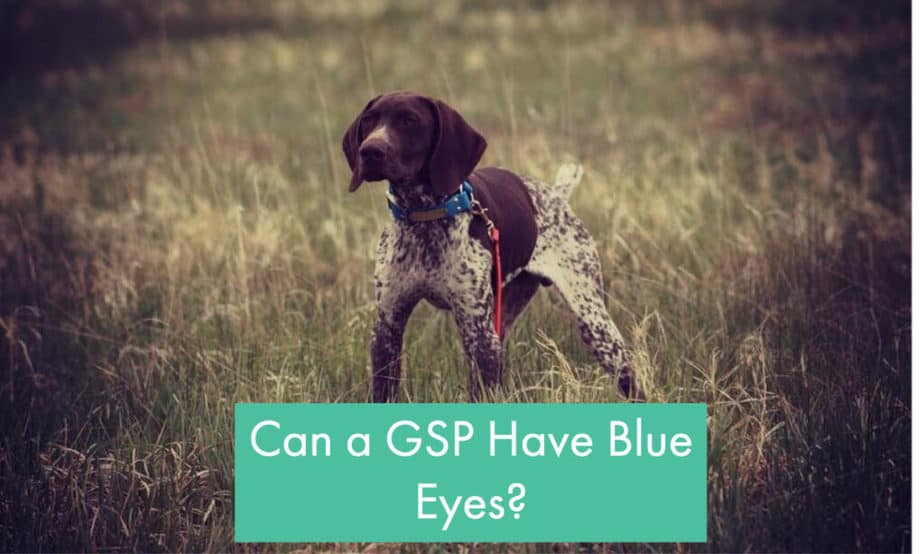German Shorthaired Pointers are among the most popular dogs within their breed category, as both field dogs and pets.
Blue-eyed dogs have a hypnotic gaze of glacial beauty; many people covet the exotic beauty of dogs with ice in their eyes.
It is logical to wonder whether the charm of a blue-eyed dog can be found in the comical German Shorthaired Pointer.

German Shorthaired Pointers can have blue eyes, although all major breed registries will disqualify these dogs from breed competitions.
Eyes that turn a milky blue with age or after injury are typically due to a disease process or structural damage to the eye.
When considering whether German Shorthaired Pointers can have blue eyes, we need to ask ourselves three questions:
- 1) What do the official breed registries say about German Shorthaired Pointer eye color?
- 2) Are the genes for blue eyes found in German Shorthaired Pointers?
- 3) If we can breed blue-eyed German Shorthaired Pointers, should we?
Do The Official Breed Registries Permit Blue Eyes In GSPs?
The American Kennel Club Association (AKC) has specific criteria governing the German Shorthaired Pointer’s (GSP) breed standard. Dogs who deviate from this breed standard will be marked down or even disqualified from breed-specific competitions.
The organization references the shape, size, position, and color of a GSP’s eyes. The eyes of a GSP should be medium-sized, almond-shaped, and shining with the good humor and intelligence characteristics of GSPs.
However, both the AKC and UK kennel club agree that dark brown eyes are the preferred color for GSPs. While the AKC states that yellow eyes are permissible but undesirable, the UK Kennel club disqualifies all GSPs with light eye colors.
Light-colored eyes include yellow and blue eyes.
The AKC makes a special note that dogs with china eyes will be disqualified from any breed competition and should never be used as breeding dogs. GSPs with china eyes have one or two light blue eyes flecked with even lighter blue or even white flecks.
What Genes Control Eye Color In GSPs?
Research into understanding the genetic profile of blue eyes in dogs is still in its early phases. Embark, a laboratory working on identifying specific genes in dogs, has recently turned its attention to sequencing blue-eyed dogs’ DNA.
A Genome-Wide Association Study (GWAS) was conducted in 2017 in which the genetic profile of 3000 dogs was cross analyzed against their phenotypical presentation.
Phenotype refers to the most active genes in a GSP, whereas genotype refers to all genes carried by a particular GSP. Some genes are “hidden” by more dominant genes and are thus “invisible.”
This study found that 75% of dogs with blue eyes had a DNA duplication near the ALX4 gene on chromosome 18. DNA duplication mutations are the results of a section of DNA being inadvertently repeated during sexual reproduction.
It is thought that this gene mutation is responsible for blue eyes in GSPs. The mutation responsible for blue eyes in GSPS is non-harmful.
Are There Blue-Eyed GSPs?
Although breeders have systematically worked to eliminate the blue-eyed gene in the GSP breeding lines, it still sometimes crops up.
Remember when I spoke about phenotype and “hidden” genes lurking in GSPs genotypes? The more dominant, brown-eyed gene “hides” the recessive gene for blue eyes.
Dominant genes always repress recessive genes, which means you need two copies of the recessive gene for the recessive gene to make a difference to your GSPs eye color.
Thus, two brown-eyed dogs, each carrying one “hidden” blue-eyed gene, can have a blue-eyed GSP puppy if mated together. The blue-eyed GSP puppy will be homozygous (.i.e., having two copies of the blue-eyed gene) for blue eyes.
How Do Blue Eyes Differ From Brown Eyes In GSPs?
Pigments are the chemicals responsible for changing the color of your GSPs coat, skin, and eyes. Only one type of pigment is found in the eyes, and this pigment is BROWN melanin.
There is no true blue or cyan pigment found in the iris of blue-eyed dogs.
The amount of melanin present in the iris of the eye determines the color. The more melanin present, the darker brown the iris; the less melanin present, the lighter the iris color.
Blue-eyed GSPs have the lowest amount of melanin in their eyes compared to dogs with chocolate brown and topaz yellow eyes.
The lack of pigment causes the shorter wavelengths of light to be scattered while longer wavelengths are absorbed. The scattering of light waves causes the eyes to appear blue in the same way the sky and ocean appear blue.
What Health Issues Are Associated With Blue-Eyed GSPs?
GSPs with blue eyes are typically as healthy as their brown-eyed counterparts. The most significant difference between non-pathological blue eyes and brown eyes is their light sensitivity.
When light hits a melanin-rich brown iris, most of the light rays are absorbed, preventing the back of the eyeball from being overloaded with light energy.
Melanin-lacking blue eyes are not efficient filters, so a higher percentage of light rays hit the sensitive retina, causing light sensitivity.
Due to the poor absorption of light rays, blue-eyed GSPs have a slightly higher risk of developing eye cancers like melanomas than brown-eyed GSPs.
Light-sensitive GSPs will not perform as well as brown-eyed GSPs when doing fieldwork on bright sunny days.
For those of you with blue eyes, imagine spending hours out in the sun without eye protection.
You squint, your eyes water, and you spend most of your time wishing you could go back inside, i.e., you cannot function effectively when your light-sensitive eyes are hurting.
GSP’s come in all sorts of color configurations, check out this resource here to GSP colors!
Why Did My GSP’s Brown Eyes Turn Blue?
Not all dogs with blue eyes were born with blue eyes; most dogs whose eyes turned blue later in life are sick with an underlying health issue or have suffered an injury.
Blows to the head, face, or eye can cause structural eye injuries. As the eye heals, scar tissue forms, making the eye appear a murky blue color.
Once the eye scar tissue has formed, the dog will more than likely be wholly or partially blind in that eye.
Disease processes that cause dogs eyes to appear a milky blue are:
- Glaucoma
- Nuclear sclerosis
- Scars from corneal ulceration
- Hereditary and acquired cataracts
- Anterior uveitis
- Corneal dystrophy
It is easy to distinguish between pathological and non-pathological blue eyes based on the clarity of the color. Milky Blue eyes are blue due to disease or trauma and should always be seen by a vet.
Blue eyes that resemble the piercing clarity of high-quality tanzanite are healthy non-problematic blue eyes.
Conclusion
There are no GSP breed registries that endorse the breeding of blue-eyed GSPs; blue-eyed GSPs cannot be registered as breeding dogs or compete in breed competitions.
Although the recessive blue-eyed gene occasionally crops up in the GSP breeding lines, most breeders actively work to eliminate the gene.
Blue-eyed GSPs are more light-sensitive and thus less effective than their brown-eyed counterparts when participating in fieldwork on a sunny day.

